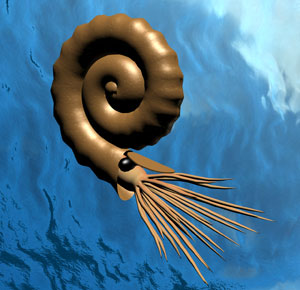Ammonites

Ammonites lived during the periods of Earth history known as the Jurassic and Cretaceous. They became extinct at the end of the Cretaceous Period at roughly the same time as the dinosaurs disappeared. They are commonly found as fossils, formed when the remains or traces of the animal became buried in sediment which later solidified into rock.
Ammonites were marine animals and had a coiled external shell similar to the modern pearly nautilus.
The ammonite's shell was divided into chambers separated by strong walls known as septa. They probably lived in water up to 100 metres deep.

Ammonites take their name from the Egyptian god Amun, known to the Greeks as Zeus Ammon.
This god is depicted on Cyrean coins and in sculpture by a head with curling ram's horns. Many genera of ammonites have names ending in -ceras from the Greek word 'keras' meaning horn.
« Back 











